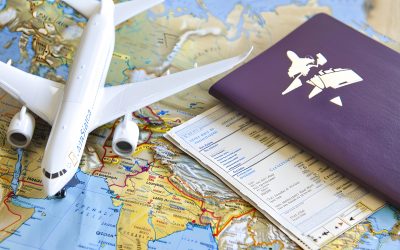Traveling by train has become one of the most appealing options for travelers seeking comfort, sustainability, and cost savings on long itineraries. Beyond being a means of transportation, trains enrich the journey by offering unique landscapes, access to less touristy destinations, and seamless connections to other transport modes. In this article, we explore the benefits of trains for long-distance travel and how they can be the perfect link in your itineraries.
Benefits of Using Trains on Long Journeys: Comfort, Sustainability, and Savings
One of the main reasons trains are so valued is their balance between comfort, sustainability, and cost-effectiveness, especially for mid-range segments of long journeys.
- Superior Comfort: Trains offer spacious seating and services that other modes of transport can’t match. On a train, you can move around freely, enjoy a meal in the dining car, or relax with stunning views from your seat. Additionally, there are no strict baggage restrictions as with airplanes, making planning for long trips easier.
- Sustainability: In a world increasingly aware of climate change, trains are one of the most eco-friendly travel options. According to the European Environment Agency, a train journey emits 77% less CO2 per passenger than a short-haul flight. Countries like France have already implemented policies eliminating domestic flights where a train alternative under 2.5 hours is available.
- Cost Savings: Trains are often more economical, especially if booked in advance or when using travel passes such as the Interrail Pass in Europe or the Japan Rail Pass in Japan. These options allow for exploring multiple destinations without worrying about additional costs.
Trains as the Backbone of Multimodal Itineraries
A significant strength of trains is their ability to integrate with other modes of transport, creating efficient and hassle-free itineraries.
For instance, a traveler can fly from their home country to a major city like Paris and then use the extensive rail network to visit nearby cities like Lyon, Strasbourg, or even cross borders to Amsterdam or Brussels. This flexibility helps reduce waiting times and costs associated with air or car travel.
Another notable example is Japan, where high-speed trains like the Shinkansen complement international flights, enabling seamless connections between large metropolises and rural regions. This multimodal model not only optimizes time but also enriches the experience by combining modern transportation with unforgettable landscapes.
The Transformative Role of High-Speed Networks and Night Trains
High-Speed Rail: Speed and Accessibility
Over the past decades, high-speed rail networks have revolutionized long-distance travel, connecting cities in record time. For example, the journey from Paris to Barcelona, which once took over 10 hours, now takes just over 6 hours thanks to the TGV and AVE trains.
These advancements not only save time but also make destinations that once seemed distant or complex to reach more accessible. In China, the high-speed train between Beijing and Shanghai has reduced a 12-hour journey to under 5, providing a comfortable alternative to air travel.
Night Trains: Combining Transport and Rest
Night trains offer an ideal solution for those looking to maximize time and reduce costs. Traveling while you sleep not only optimizes your schedule but also adds a touch of adventure to the trip.
Iconic routes include the Nightjet in Europe, connecting cities like Vienna, Zurich, and Berlin, or the Trans-Siberian trains that cover vast distances in Russia with unique scenic views. These services often offer private cabins, shared berths, and relaxing spaces, making the journey an unforgettable experience.
Direct Connection to Local Tourism and Remote Destinations
Trains not only connect major cities; they also open the door to less touristy regions, allowing travelers to explore authentic destinations far from the crowds.
For example:
- In Switzerland, panoramic trains like the Glacier Express traverse the Alps, linking Zermatt with St. Moritz while passing through glaciers, historic bridges, and spectacular tunnels.
- In Spain, the line connecting León to Ponferrada crosses mountains and valleys along the Camino de Santiago, offering unique views and access to natural enclaves.
These routes also boost local economies by attracting tourism to rural areas, benefiting small communities and fostering sustainable development.
Trains vs. Planes: A Comparison of Costs and Time
Choosing between train and plane depends on factors like budget, distance, and personal preferences. However, trains excel on mid-range and short-distance journeys.
- Costs: While plane tickets might initially seem cheaper, trains eliminate additional expenses like airport transfers, baggage fees, and booking fees.
- Effective Time: Trains avoid long security checks and boarding times, making them a more efficient option for journeys up to 800 kilometers.
- Experience: While planes are practical, trains offer a relaxed experience with panoramic views and greater freedom of movement.
For instance, the Madrid-Barcelona AVE journey takes about 2 hours and 30 minutes, nearly the same as a flight when considering airport procedures.
Traveling by Train: A More Conscious and Enriching Experience
Traveling by train isn’t just about reaching your destination—it’s about enjoying the journey as an integral part of the experience. This approach fosters a slower, more mindful type of tourism where travelers can:
- Relax and disconnect from stress.
- Admire breathtaking landscapes from the comfort of their seat.
- Interact with fellow passengers and learn about local cultures.
Choosing trains also contributes to a more sustainable future, reducing environmental impact and promoting a more respectful model of tourism.
Conclusion
Trains are much more than a mode of transport; they are a tool to transform your long journeys into unforgettable experiences. From comfort and sustainability to their ability to connect major cities with remote destinations, trains are a choice that blends practicality with memorability.
Next time you plan a long itinerary, consider incorporating train travel. Whether it’s for an overnight journey, exploring off-the-beaten-path regions, or simply relaxing while admiring the scenery, trains have a lot to offer.







